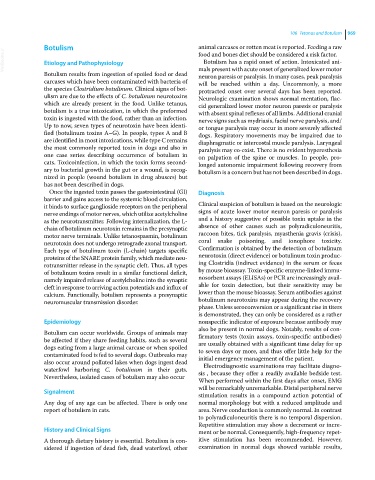Page 1031 - Clinical Small Animal Internal Medicine
P. 1031
106 Tetanus and Botulism 969
Botulism animal carcases or rotten meat is reported. Feeding a raw
VetBooks.ir Etiology and Pathophysiology food and bones diet should be considered a risk factor.
Botulism has a rapid onset of action. Intoxicated ani-
Botulism results from ingestion of spoiled food or dead mals present with acute onset of generalized lower motor
neuron paresis or paralysis. In many cases, peak paralysis
carcases which have been contaminated with bacteria of will be reached within a day. Uncommonly, a more
the species Clostridium botulinum. Clinical signs of bot- protracted onset over several days has been reported.
ulism are due to the effects of C. botulinum neurotoxins Neurologic examination shows normal mentation, flac-
which are already present in the food. Unlike tetanus, cid generalized lower motor neuron paresis or paralysis
botulism is a true intoxication, in which the preformed with absent spinal reflexes of all limbs. Additional cranial
toxin is ingested with the food, rather than an infection. nerve signs such as mydriasis, facial nerve paralysis, and/
Up to now, seven types of neurotoxin have been identi- or tongue paralysis may occur in more severely affected
fied (botulinum toxins A–G). In people, types A and B dogs. Respiratory movements may be impaired due to
are identified in most intoxications, while type C remains diaphragmatic or intercostal muscle paralysis. Laryngeal
the most commonly reported toxin in dogs and also in paralysis may co‐exist. There is no evident hyperesthesia
one case series describing occurrence of botulism in on palpation of the spine or muscles. In people, pro-
cats. Toxicoinfection, in which the toxin forms second- longed autonomic impairment following recovery from
ary to bacterial growth in the gut or a wound, is recog- botulism is a concern but has not been described in dogs.
nized in people (wound botulism in drug abusers) but
has not been described in dogs.
Once the ingested toxin passes the gastrointestinal (GI) Diagnosis
barrier and gains access to the systemic blood circulation,
it binds to surface ganglioside receptors on the peripheral Clinical suspicion of botulism is based on the neurologic
nerve endings of motor nerves, which utilize acetylcholine signs of acute lower motor neuron paresis or paralysis
as the neurotransmitter. Following internalization, the L‐ and a history suggestive of possible toxin uptake in the
chain of botulinum neurotoxin remains in the presynaptic absence of other causes such as polyradiculoneuritis,
motor nerve terminals. Unlike tetanospasmin, botulinum raccoon bites, tick paralysis, myasthenia gravis (crisis),
neurotoxin does not undergo retrograde axonal transport. coral snake poisoning, and ionophore toxicity.
Each type of botulinum toxin (L‐chain) targets specific Confirmation is obtained by the detection of botulinum
proteins of the SNARE protein family, which mediate neu- neurotoxin (direct evidence) or botulinum toxin produc-
rotransmitter release in the synaptic cleft. Thus, all types ing Clostridia (indirect evidence) in the serum or feces
of botulinum toxins result in a similar functional deficit, by mouse bioassay. Toxin‐specific enzyme‐linked immu-
namely impaired release of acetylcholine into the synaptic nosorbent assays (ELISAs) or PCR are increasingly avail-
cleft in response to arriving action potentials and influx of able for toxin detection, but their sensitivity may be
calcium. Functionally, botulism represents a presynaptic lower than the mouse bioassay. Serum antibodies against
neuromuscular transmission disorder. botulinum neurotoxins may appear during the recovery
phase. Unless seroconversion or a significant rise in titers
is demonstrated, they can only be considered as a rather
Epidemiology nonspecific indicator of exposure because antibody may
also be present in normal dogs. Notably, results of con-
Botulism can occur worldwide. Groups of animals may firmatory tests (toxin assays, toxin‐specific antibodies)
be affected if they share feeding habits, such as several are usually obtained with a significant time delay for up
dogs eating from a large animal carcase or when spoiled to seven days or more, and thus offer little help for the
contaminated food is fed to several dogs. Outbreaks may initial emergency management of the patient.
also occur around polluted lakes when dogs ingest dead Electrodiagnostic examinations may facilitate diagno-
waterfowl harboring C. botulinum in their guts. sis , because they offer a readily available bedside test.
Nevertheless, isolated cases of botulism may also occur
When performed within the first days after onset, EMG
will be remarkably unremarkable. Distal peripheral nerve
Signalment
stimulation results in a compound action potential of
Any dog of any age can be affected. There is only one normal morphology but with a reduced amplitude and
report of botulism in cats. area. Nerve conduction is commonly normal. In contrast
to polyradiculoneuritis there is no temporal dispersion.
Repetitive stimulation may show a decrement or incre-
History and Clinical Signs ment or be normal. Consequently, high‐frequency repet-
A thorough dietary history is essential. Botulism is con- itive stimulation has been recommended. However,
sidered if ingestion of dead fish, dead waterfowl, other examination in normal dogs showed variable results,

